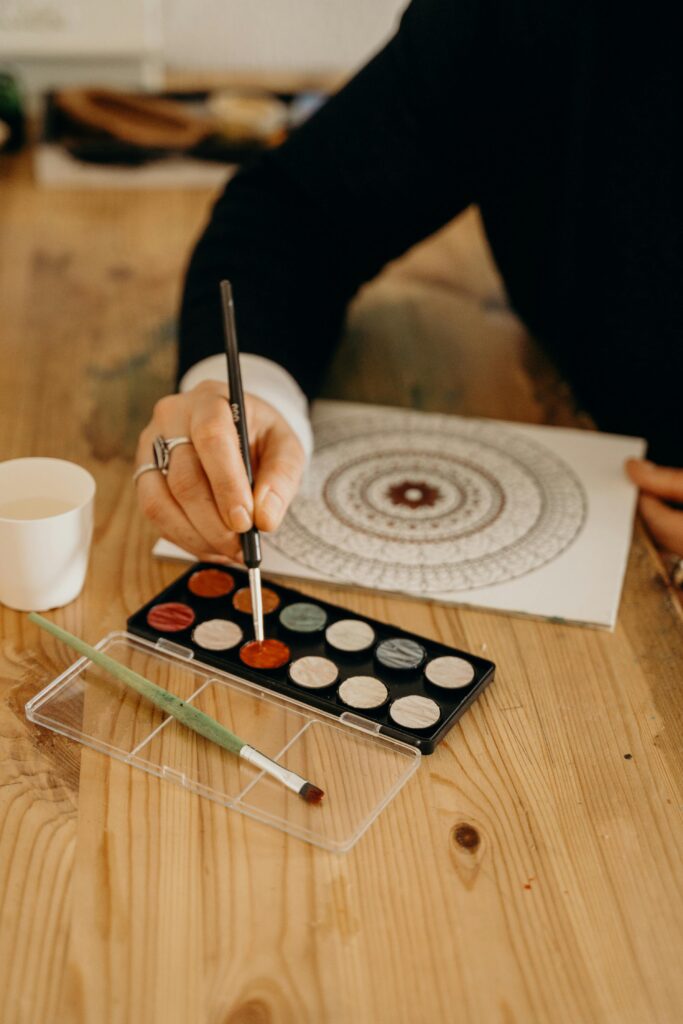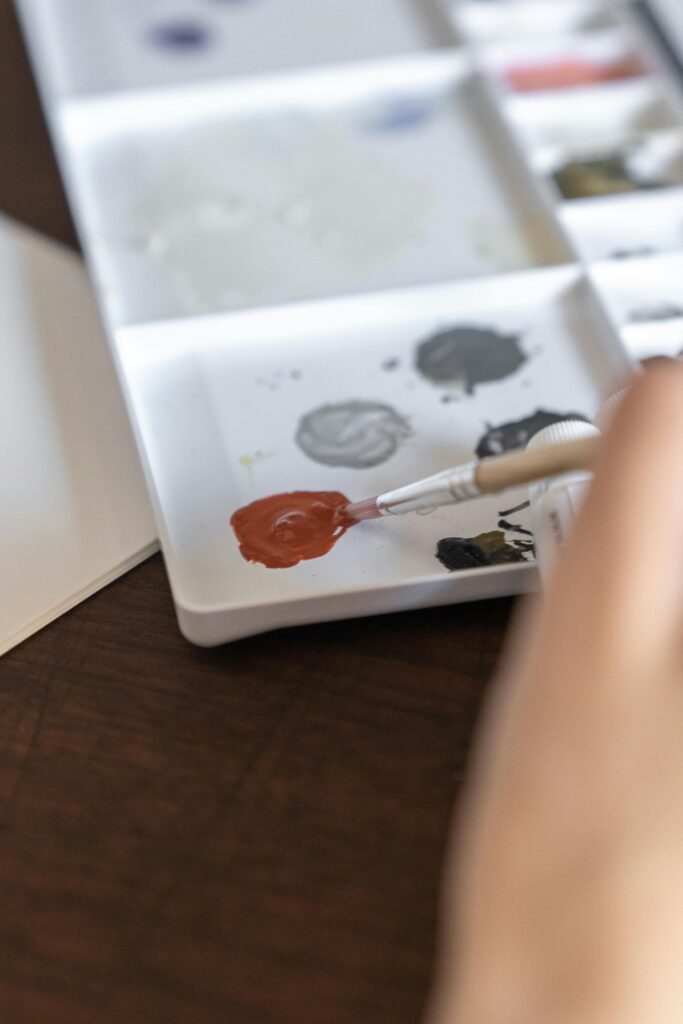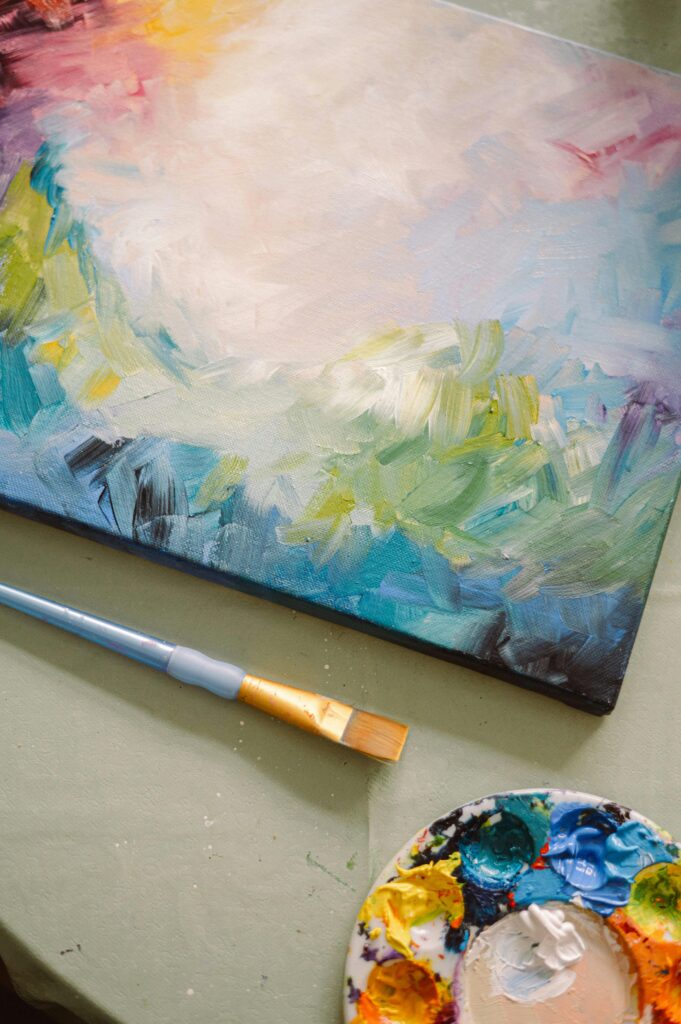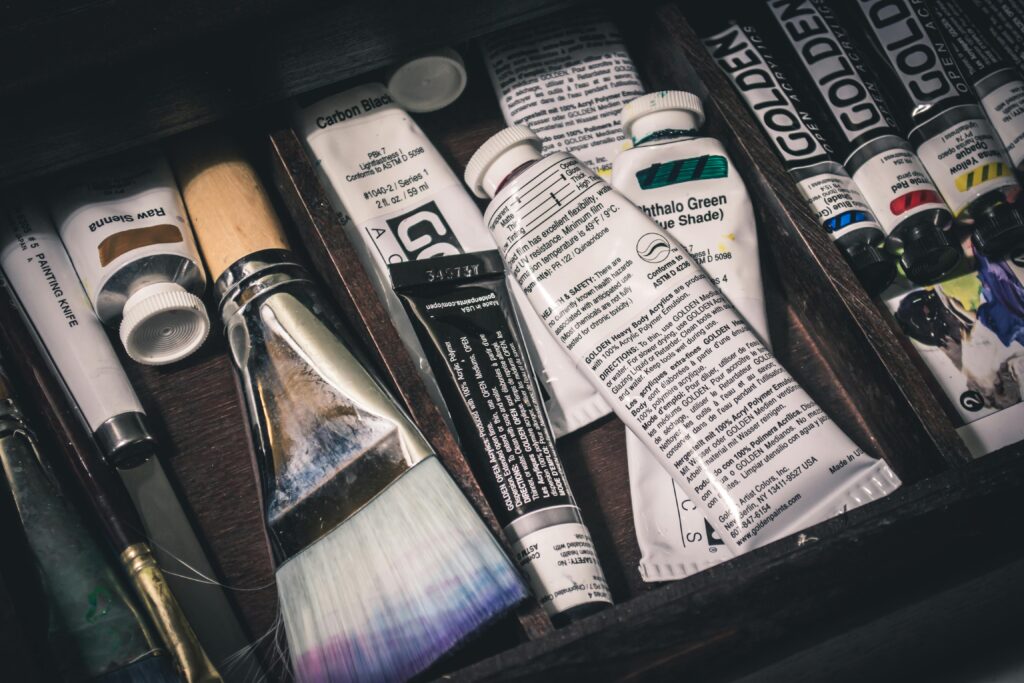What Collectors Look for Before Buying Work by Emerging Women Artists

At small shows, you can always spot the collectors. They move slowly, eyes lingering, heads tilting just slightly. They’re not rushing toward a sale, they’re trying to understand. They’ll glance from the painting to the artist, then back again, as if looking for a quiet match between what’s seen and what’s felt. Before they buy anything, they want to sense that the person behind the work is real, steady, and creating from somewhere honest.
For women artists still finding their place, that kind of presence matters more than people realize. Collectors often notice what the artist herself might overlook, the confidence in how a piece is hung, the language in a caption, the way she talks about her process. They read between the lines. What they’re hoping to find isn’t perfection, but a pulse, that spark that says, I know what I’m making and why it matters to me.
Many collectors are drawn to work that carries a certain quiet persistence. They can feel when an artist isn’t trying to please anyone, just trying to tell the truth as she sees it. When they see that kind of focus, they stay curious. They’ll look at your older pieces, your experiments, your shifts in direction. They’re searching for continuity, for signs that your art has roots, not just reach.
They also pay attention to how your world feels. The tone of your website, your captions, even how you document your studio, all of it builds a small map of who you are. They don’t need it to be polished; they need it to feel genuine. A photo of a messy table, a note about what you’re thinking through, those things create trust. They help collectors step inside your process and see themselves in the story.
What often surprises artists is how emotionally intuitive collectors are. They sense when a piece was made out of curiosity versus when it was made out of pressure. They can tell when something’s been over-edited or when it’s been lived with long enough to breathe. The art world talks a lot about trends, but the truth is, collectors who love women’s work are often looking for emotion that feels unguarded, a story that hasn’t been ironed flat.
In the end, what they want most is connection. They want to believe that their purchase means more than owning something beautiful; it’s a way of joining a journey. When they see an artist building a life around her work with care and conviction, that belief takes root. And that’s when collecting stops feeling like a transaction and starts feeling like trust.

Stop Thinking About Selling, Start Thinking About Staying
Collectors rarely fall in love with a single piece. What they’re really falling for is your consistency, the way your work keeps showing up with direction. They want to feel that if they invest in you today, your voice will still be worth following tomorrow. That doesn’t mean sticking to one subject forever, it means building a thread through your work that feels alive, not scattered.
Too many emerging artists chase visibility without realizing collectors are chasing stability. When they see you experimenting, they look for signs that your experiments are leading somewhere. If each piece looks like a different artist made it, it can feel like chaos instead of growth. They want to see that you’re in conversation with your own ideas.
It helps to keep a rhythm, even a subtle one. Maybe your color palette evolves slowly, or the tone of your themes deepens over time. That quiet continuity builds trust. Think of it as emotional consistency, the feeling that no matter how much your technique shifts, your inner world stays traceable.
This doesn’t mean playing it safe. Collectors respect artists who take risks, as long as those risks feel intentional. They love seeing courage in context, when a new series challenges your past work but still connects to your core. That’s how they know you’re growing, not drifting.
A good way to test this is by laying out your past year’s work side by side. Does it tell a story? Does it feel like one evolving vision, or twelve random ideas? Collectors do that in their minds every time they see your portfolio. Your job is to make that narrative easy to follow.
When you stop trying to “sell” and start thinking about how to “stay,” everything about your presentation changes. Your website feels calmer, your captions sound more certain, your choices look deliberate. That sense of steadiness is what collectors read as value.
Let Them See the Person, Not Just the Paint
Collectors aren’t moved by perfect bios, they’re moved by recognition. They want to sense the person behind the canvas, the heartbeat beneath the brush. When you share your process, your rituals, or the questions that drive your work, you invite them into your world instead of keeping them outside looking in.
Women artists sometimes feel pressure to appear either flawless or endlessly humble. Neither helps. Collectors connect with artists who are human in public, who talk about both the beauty and the uncertainty of making art. That honesty isn’t weakness; it’s what gives collectors something real to believe in.
Try weaving small truths into your storytelling. Talk about the moment a piece shifted direction, or the thought you couldn’t shake while working on it. These details don’t need to sound poetic, they just need to sound true. The less you perform, the more people trust you.
Collectors are surprisingly intuitive about tone. They can sense when your words are written for them versus when they come from your actual studio life. So instead of trying to sound like a brand, sound like a person who loves what they do. That’s always enough.
If you’re unsure how much to share, think of it like a studio visit in text form. You wouldn’t reveal everything, but you’d let someone peek behind the curtain just enough to see your dedication. That’s what makes them feel connected.
In a world that’s constantly edited, showing a little reality feels radical. A messy desk, a half-done sketch, a sentence that sounds like you, these are small gestures that whisper, I’m real. And that’s exactly what a collector wants to hear.
Make Your Work Easy to Read, Not Easy to Explain
Collectors don’t need to “get” everything at once, they need to feel oriented. What turns them away isn’t complexity, it’s confusion. When your work feels impossible to approach or overly explained, it loses emotional entry points. The goal isn’t to simplify your ideas, but to help people enter them.
One of the best ways to do this is by curating how you show your work. Group pieces with shared emotion or theme. Let your sequence tell a story. When a collector scrolls or walks through your images, they should sense a natural rhythm that says, This artist knows where she’s going.

You can also use language wisely. Avoid the temptation to over-define your concept. Collectors want clues, not conclusions. They like discovering meaning for themselves. Offer enough to frame the experience, but leave space for their interpretation.
Women artists often feel they have to justify their seriousness through language, but clarity doesn’t come from using big words, it comes from using true ones. Write like you’re explaining your work to someone curious, not someone judging.
Pay attention to your visuals too. High-quality images, consistent lighting, and simple backgrounds all help your work speak clearly. Presentation isn’t vanity, it’s part of how you translate your world for others to step into.
When your work feels readable, collectors linger longer. They start to imagine it in their home, in their collection, in conversation with other pieces they own. That’s the moment you want, to be seen not as mystery, but as meaning.
Let Your Prices Tell a Story Too
Collectors notice pricing before they ever ask about it. Your price list is part of your narrative, it tells them how you value your work and how you see your future. When it’s inconsistent, they read hesitation. When it’s thoughtful, they read confidence.
Start by looking at your prices across your body of work. Do they follow a pattern that makes sense? Are they growing with your practice? Steady increases tell collectors that you’re building momentum, not guessing. Sudden leaps without context make them wary.
Pricing also communicates how seriously you take yourself. If you undervalue your work, you’re not making it easier for someone to buy, you’re signaling that you’re unsure. Collectors who support emerging women artists often want to uplift, but not rescue. They want to invest, not correct.
Be transparent about your reasoning. Share size, material, or edition logic if relevant. That transparency builds credibility. It also helps collectors talk about your work to others, something they actually enjoy doing when the story makes sense.
Confidence in pricing doesn’t mean rigidity. It’s okay to offer smaller works or studies at accessible rates. Just make sure they still feel aligned with your overall trajectory. Every piece you release should fit into the bigger picture of your practice.
When your pricing tells a clear story, collectors trust your self-awareness. And that trust is contagious. It doesn’t just make one sale easier, it makes every conversation about your work stronger.
Build the Kind of Visibility That Feels Earned
Collectors often follow artists long before they buy from them. They’re watching how you move through the art world, how you show up online, how you collaborate, how you evolve. They’re not impressed by constant posting; they’re impressed by purposeful presence.
The trick isn’t to be everywhere, it’s to be somewhere with intention. Choose platforms that feel natural to your rhythm, and show up there thoughtfully. Quality of engagement matters far more than volume. Collectors value artists who curate their digital spaces as carefully as their canvases.
They also look at who you’re aligned with. Group shows, collaborations, or residencies add context to your name. When your presence in those spaces feels earned, it adds credibility. When it feels random, it adds noise. Collectors trust coherence.
One underrated detail: they remember tone. Whether you’re responding to comments, writing captions, or announcing shows, your voice becomes part of your identity. A calm, grounded tone often communicates maturity faster than any CV.
You don’t need to manufacture momentum. Show the work. Share what matters. Let the rest be quiet. Over time, that quiet builds into something stronger than hype, it builds into recognition.
Collectors love the feeling of discovering someone genuine. When they realize your growth wasn’t engineered, but evolved, they stay close. That’s how long-term collectors are born: through patience meeting integrity.
Create a World They Want to Belong To
Every artist creates not just objects, but atmospheres. Collectors buy into that world as much as the work itself. They’re drawn to artists who make them feel part of something bigger, something textured, intentional, and emotionally resonant.
Think of your world as everything that happens around your work. Your tone, your imagery, your spaces, your collaborations, all of it forms an ecosystem. When that ecosystem feels coherent, it makes collectors feel anchored. They want to join, not just observe.
Building that world doesn’t mean crafting a brand; it means creating belonging. Maybe your studio updates feel intimate. Maybe your newsletters sound like letters, not announcements. Every detail is a chance to make people feel connected to your creative life.
Collectors are emotionally intelligent. They don’t just see what you make; they sense how you live with it. They can tell when your art feels integrated into your life versus when it’s being performed. The former feels magnetic.
The most memorable women artists create small universes, visual, emotional, and even social ones, that invite others in. Their collectors often say, I didn’t just buy a painting; I wanted to be part of her world. That’s when art becomes more than a purchase, it becomes relationship.
When you build your practice around meaning, connection follows. Collectors don’t need perfection. They need a world that feels alive, open, and real. And that world starts with you.

The Collector’s Eye Is Slower Than You Think
Collectors don’t rush. They might follow your work for months, or even years, before making a decision. That time isn’t hesitation; it’s observation. They’re watching to see how your practice matures, how your exhibitions unfold, how your work holds up in different settings. The longer they stay interested, the more they start to feel personally invested.
This slower rhythm can be frustrating for emerging artists who live in the instant-feedback world of likes and shares. But collectors operate on a different timeline. They’re not reacting, they’re studying. The way you manage your pace, your tone, and your evolution tells them whether your work will age well in their collection.
That’s why it helps to think long-term. Instead of chasing immediate sales, cultivate visibility that lasts. Keep your updates steady and your voice authentic. Let them see how your process unfolds across seasons. Collectors appreciate seeing the slow build, it reassures them that their belief in you won’t expire in six months.
The best collectors fall for artists they feel they’ve discovered in real time. Every new piece, every thoughtful post, becomes a breadcrumb in that discovery. When they finally decide to buy, it feels less like a purchase and more like joining a story they’ve been watching grow.
So if you’re feeling unseen, remember that sometimes you’re not being ignored, you’re being quietly studied. The key is to stay consistent while being patient. That patience doesn’t mean waiting, it means continuing visibly, even when the response is silent.
Collectors move slowly because they take art seriously. When they buy, they’re not buying a moment, they’re buying a journey they believe will keep unfolding. And that’s the most meaningful kind of commitment.
Keep Your Work Grounded, Even When It Glows
Collectors love ambition, but they love authentic grounding even more. When they see a young artist getting early attention, they’re quietly observing how she handles it. Do her choices still feel connected to her roots, or has the work started performing for the audience instead of the idea? Grounded work always reads stronger, it carries a sense of calm confidence that no amount of hype can fake.
Being grounded doesn’t mean staying small. It means staying aware, of your own instincts, of the materials you’re using, of the reason you began making art in the first place. When that awareness is visible, collectors sense it immediately. It’s what makes a piece feel “lived in” instead of decorative.
Collectors often look for the weight beneath the shine. They notice when beauty is used to reveal something honest instead of to hide something shallow. That balance, of grace and gravity, is what separates a good painting from a memorable one.
To stay grounded, keep your studio process close. Don’t let external opinions pull your focus. If a series is selling well, let it evolve naturally instead of rushing to replicate it. If a piece didn’t land as you hoped, study it, don’t abandon it. This kind of steadiness builds a depth that collectors trust.
Grounded artists also tend to make better decisions with opportunity. They know which shows feel aligned and which ones are distractions. Collectors can sense that discernment, it signals maturity. It tells them you’re leading your career, not being led by it.
In a world obsessed with quick attention, groundedness feels radical. It slows people down. It makes them look longer. And sometimes, that extra moment of stillness is what turns a maybe into a yes.
The Small Gestures That Build Big Trust
Collectors remember how artists make them feel long before they remember what they bought. Trust doesn’t come from grand gestures; it’s built through the small, consistent signs of care that make people feel respected. How you reply to an inquiry, how you pack a piece, how you follow up after a show, all of it matters more than most artists realize.
When someone reaches out about your work, they’re already half emotionally invested. Responding thoughtfully, without rushing, but with warmth, can turn that curiosity into confidence. A simple thank you, a short insight about the piece, or even sharing the story behind it makes the exchange memorable.
Collectors also pay attention to how you present logistics. Clear communication about pricing, framing, shipping, or editions tells them you’re organized and self-respecting. That professionalism doesn’t make you less artistic, it makes you trustworthy.
If someone buys from you, the relationship shouldn’t end at payment. Following up with a handwritten note, a small photo of the piece installed, or even a short message after delivery adds human touch. Those gestures often turn a one-time buyer into a lifelong supporter.
Women artists sometimes worry that friendliness might seem unprofessional, but collectors usually find it refreshing. They want to feel seen as people, not just transactions. A warm, thoughtful exchange often becomes part of the art’s story in their home.
The truth is, collectors buy art, but they collect relationships. Every detail that shows care and respect deepens that bond. And in a career built on trust, those bonds are everything.

Let the Work Speak, but Don’t Leave It Alone
There’s power in silence, but too much mystery can distance you. Collectors don’t need every answer, but they do need a way in. Artists sometimes assume that “letting the work speak for itself” means avoiding conversation, but in truth, your words can help people listen more closely.
When you talk about your art, think of it as building a bridge, not giving a lecture. A few grounded insights about what moved you to make a piece or what you discovered in the process are enough to invite connection. Collectors appreciate that kind of openness, it makes them feel part of the journey.
Avoid turning your statements into manifestos. Speak simply. Let your tone reflect the rhythm of your practice. If your work is quiet, let your language be calm. If it’s bold, let your words hold that energy. The alignment between your visual and verbal worlds builds authenticity.
Collectors also value artists who listen. When someone shares what they see in your work, ask questions. Let them describe their experience. That exchange not only helps you understand your audience, it makes them feel seen in return. That’s a powerful emotional exchange.
Your website, captions, and interviews all shape how people approach your art. Think of them as touchpoints, not marketing. The best ones sound like conversations, not announcements. When your words carry care, they add warmth to the way your work is received.
Collectors don’t want silence, they want sincerity. When you give your art a voice, however small, it stops being an object and becomes an experience. And that experience is what people buy, again and again.
